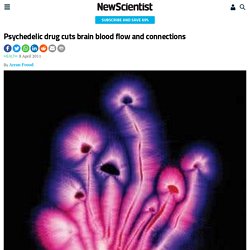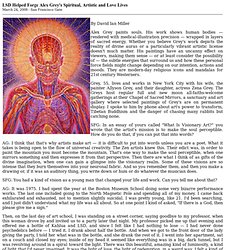

Psychedelic Health. By Arran Frood Psychedelic drug users throughout the ages have described their experiences as mind-expanding.

They might be surprised, therefore, to hear that psilocybin – the active ingredient in magic mushrooms – actually decreases blood flow as well as connectivity between important areas of the brain that control perception and cognition. The same areas can be overactive in people who suffer from depression, making the drug a potential treatment option for the condition. The study is the first time that psilocybin’s effects have been measured with fMRI, and the first experiment involving a hallucinogenic drug and human participants in the UK for decades. Robin Carhart-Harris at Imperial College London and colleagues recruited 30 volunteers who agreed to be injected with psilocybin and have their brain scanned using two types of fMRI. Low flow Less blood flow was seen in the brain regions known as the thalamus, the posterior cingulate and the medial prefrontal cortex. Mood swing. Slideshow: Scientists Analyze Drawings by an Acid-Tripping Artist. Credit: sxc.hu user FOTOMO The following nine drawings were made a half century ago by an artist under the influence of LSD, or acid, during an experiment designed to investigate the psychedelic drug's effects .

The unnamed artist was given two 50-microgram doses of LSD, one 65 minutes after the other, and had access to an activity box full of crayons and pencils. The subject of his art was the assisting doctor who administered the drug. Though records of the identity of the principal researcher have been lost, it was probably a University of California-Irvine psychiatrist, Oscar Janiger. Janiger, known for his LSD research, died in 2001. "I believe the pictures are from an experiment conducted by the psychiatrist Oscar Janiger starting in 1954 and continuing for seven years, during which time he gave LSD to over 100 professional artists and measured its effects on their artistic output and creative ability.
Psychedelia. Psychedelia is a name given to the subculture of people who use psychedelic drugs, and a style of psychedelic artwork and psychedelic music derived from the experience of altered consciousness that uses highly distorted and surreal visuals, sound effects and reverberation, and bright colors and full spectrums and animation (including cartoons) to evoke and convey to a viewer or listener the artist's experience while using such drugs. The term "psychedelic" is derived from the Ancient Greek words psuchē (ψυχή - psyche, "mind") and dēlōsē (δήλωση - "manifest"), translating to "mind-manifesting". Psychedelic states may be elicited by various techniques, such as meditation, sensory stimulation[1] or deprivation, and most commonly by the use of psychedelic substances.
When these psychoactive substances are used for religious, shamanic, or spiritual purposes, they are termed entheogens. Etymology[edit] To make this mundane world sublime, Take half a gram of phanerothyme History[edit] In art[edit] Erowid. 10 Scientific and Technological Visionaries Who Experimented With Drugs. Same here.

We evolved along with, and because of, our diet. There weren't any classifications of "illegal drugs" back then, and these things flourish in all sorts of conditions in the wild - it's hard not to imagine at least occasional consumption. Considering mankind's predilection to experimenting with consciousness, along with the unique effects of these substances (including euphoria), it was probably more than occasional.
If these fungi were part of a diet over time, they'd likely have some effect on our development. At the very least, to assume that these type of natural and prolific plants/substances had no part in our evolution would seem foolish. I just love the idea of psychoactive botanicals spurring hominid consciousness to a higher quantum state — the booster shot needed to make that leap forward in intelligence. SExpand Exactly! Entheology. By David Ian Miller Alex Grey paints souls.

His work shows human bodies — rendered with medical-illustration precision — wrapped in layers of sacred energy. Whether you believe Grey's work depicts the reality of divine auras or a particularly vibrant artistic license doesn't much matter. His paintings have an uncanny effect on viewers, making them sense — or at least consider the possibility of — the subtle energies that surround us and how these personal force fields might change depending on our intention, actions and moods. They are modern-day religious icons and mandalas for 21st century Westerners. Grey, 55, lives and works in New York City with his wife, the painter Allyson Grey, and their daughter, actress Zena Grey.
SFG: In an essay of yours called "What Is Visionary Art? " AG: I think that that's why artists make art — it is difficult to put into words unless you are a poet. SFG: You had a kind of vision as a young man that changed your life and work. AG: It was 1975. Psychedelic Brain Scans. Progressive psyTrance.